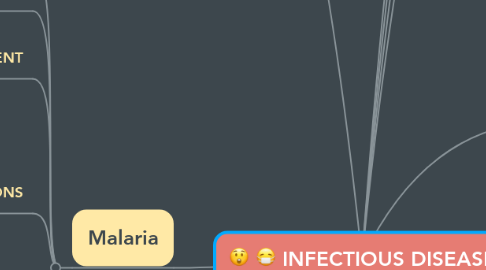
1. carrier : people who have pathogens but don't have disease themselves
2. caused by pathogens
3. transmission : the way pathogens pass from one host to another
4. vaccination : major control measure
5. Cholera
5.1. Vibrio cholerae (severe diarrhea, dehydration)
5.2. occurs when people can't access clean water
5.3. ¾ of them are symptomless carrier
5.4. spreading through contaminated faeces
5.5. multiply in small intestine
5.6. Choleragen : disrupts epithelium function→ makes water and salts leave the blood
5.7. TREATMENT
5.7.1. IV fluids containing salts and glucose
5.7.2. oral rehydration therapy
5.8. PREVENTIONS
5.8.1. sewage treatment cleans piped water
5.8.2. washing our hands
5.8.3. vaccination
5.9. STRAINS
5.9.1. 1990s→ 01 strain (Bangladesh)
5.9.2. 1961→ EI Tor (Indonesia)
5.9.3. 1992→ 0139 [V. Cholerae] (Chennai)
6. Malaria
6.1. protista Plasmodium falciparum, P. vivax, P. ovale, P. malariae
6.2. occurs when bitten by an infected Anopheles mosquito, blood transfusion, reused of unsterile needles
6.3. TREATMENT
6.3.1. drugs (e.g. quinine, chloroquine, mefloquine)
6.3.2. prophylatic drugs (preventative) (e.g. progvanil, antibiotic doxycycline)
6.4. PREVENTIONS
6.4.1. main ways
6.4.1.1. reduce mosquitoes
6.4.1.2. use preventive drugs
6.4.2. bioligical control
6.4.2.1. stocking fish in water which feed on mosquito's larvae
6.4.2.2. spraying bacterium Bacillus thuringiensis which kills mosquito larvae
6.5. WORLDWIDE CONTROL
6.5.1. worldwide eradication programme
6.5.1.1. 40% of the world's population living in a risk malaria place
6.5.2. wasn't generally successful
6.5.2.1. cause
6.5.2.1.1. plasmodium became resistant to drugs
6.5.2.1.2. mosquito became resistant to insecticide
6.5.2.2. what can we do now
6.5.2.2.1. improve diagnosis
6.5.2.2.2. improve supply of effective drugs
6.5.2.2.3. promote appropriate methods to prevent transmission
7. Antibiotics
7.1. a drug that kills/stop the growth of bacteria
7.2. it attacks
7.2.1. synthesis of bacterial cell walls
7.2.2. protein activities in the cell surface membrane
7.2.3. enzyme action
7.2.4. DNA synthesis
7.2.5. protein synthesis
7.3. why do the penicillin doesn't affect human cells
7.3.1. our cells do not have walls
7.4. autolysins : enzymes in newly formed bacteria
7.4.1. make little holes in its cell wall
7.4.2. these holes allow walls to strech so new peptidoglycan chains can link together
7.4.3. penicillin prevents these chains from linking up
7.4.4. autolysins keep making holes (the wall gets weaker)
7.4.5. the cell wall cannot stand the pressure potential from osmosis and burst
7.5. RESISTANCE
7.5.1. penicillin has no effect on M. tuberculosis because it has thick cell walls and has enzymes that breakdown penicillin
7.5.2. protein in other bacteria can inactive antibiotics and pump out antibiotics
7.5.3. became resistant if they gain a gene coding for a protein that protecs them
7.5.4. B-lactamase (penicillinase) : enzyme that destroy penicillin
7.5.5. became resistant if people don't follow the dose prescribed, making bacteria survive and occur mutation
7.5.6. vertical transmission: spreading antibiotic resistance in a population of bacteria trough cell division
7.5.7. horizontal transmission: the resistance genes are in plasmids, transfered during conjugation
7.5.8. multiple resistance: resistance genes for several different antibiotics
7.5.9. carbapens: the last antibiotics used to treat multiple resistance
8. Measles
8.1. Measles morbillivirus
8.2. multiple in the upper respiratory tract (nasal cavity and trachea)
8.3. no symptoms for 8-14 days
8.3.1. rash and fever
8.3.2. cough
8.3.3. runny nose
8.4. TREATMENT
8.4.1. bed rest
8.4.2. medicine lo lower the fever
8.5. COMPLICATIONS
8.5.1. pneumonia
8.5.2. ear and sinus infection
8.5.3. brain damage
8.6. TRANSMISSION
8.6.1. trough sneeze and cough containing virus
8.6.2. rarely affect infants < 8 months→ still have passive immunity from the placenta
8.7. PREVENTIONS
8.7.1. vaccine
8.8. fatal!!! among malnourished → vitamin A deficiency
9. AIDS
9.1. Human Immunodeficiency Virus
9.2. occurs during sexual intercourse, infected bloid and syringes, mother to fetus
9.3. attacks T helper lymphocytes→ body unable to defend itself against infection
9.4. not a disease!?!?!
9.4.1. a collection of disease caused by HIV infection
9.4.2. infection that leads to AIDS
9.4.2.1. Oral Trush by Candida albicans
9.4.2.2. Pneumonia by Pneumocytis jiroveci
9.4.2.3. Dementias
9.4.2.4. Skin Cancer, Kaposi's sarcoma
9.5. TREATMENT
9.5.1. drug therapy to slow down
9.5.2. Zidovudine→ stop replication
9.6. PREVENTIONS
9.6.1. public health measures
9.6.2. condoms, femidoms
9.7. CONTROL
9.7.1. contact tracing
9.7.2. testing donated blood
9.7.3. HIV testing
